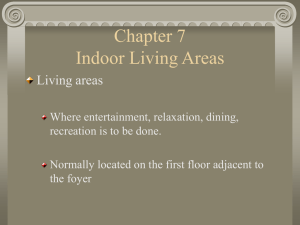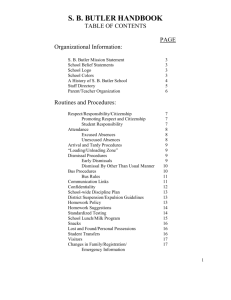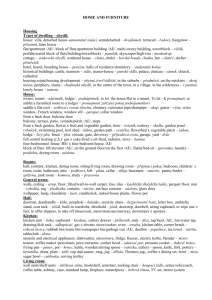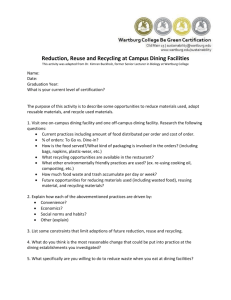Problem Set 3 Solutions out
advertisement
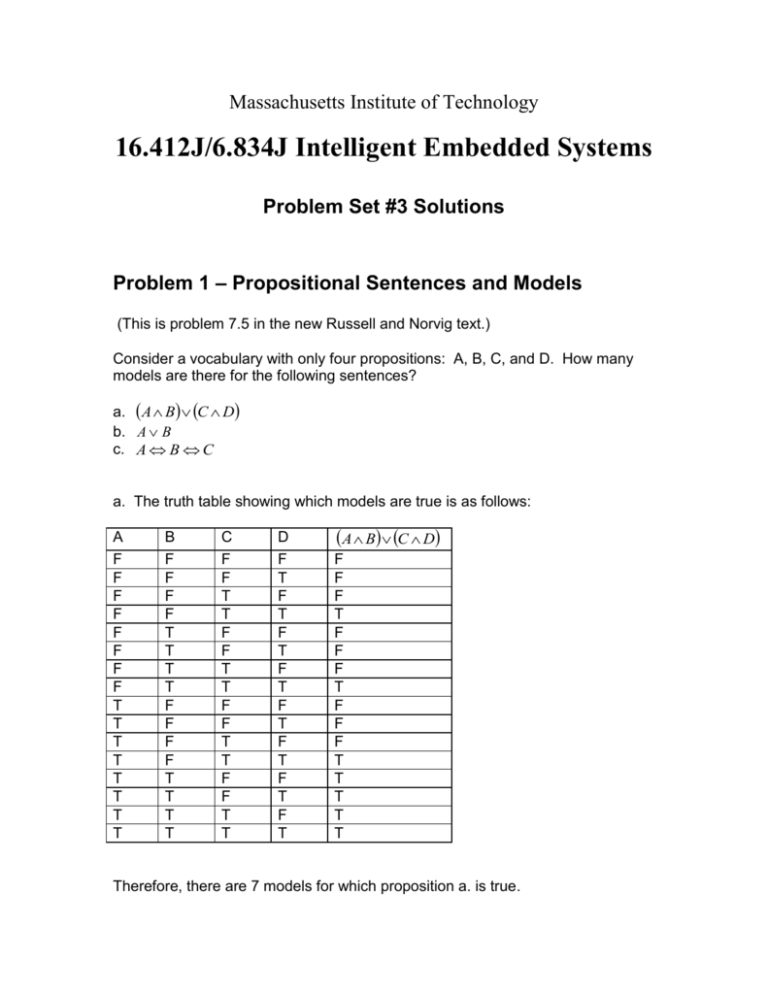
Massachusetts Institute of Technology 16.412J/6.834J Intelligent Embedded Systems Problem Set #3 Solutions Problem 1 – Propositional Sentences and Models (This is problem 7.5 in the new Russell and Norvig text.) Consider a vocabulary with only four propositions: A, B, C, and D. How many models are there for the following sentences? a. A B C D b. A B c. A B C a. The truth table showing which models are true is as follows: A F F F F F F F F T T T T T T T T B F F F F T T T T F F F F T T T T C F F T T F F T T F F T T F F T T D F T F T F T F T F T F T F T F T A B C D F F F T F F F T F F F T T T T T Therefore, there are 7 models for which proposition a. is true. b. The truth table showing which models are true is as follows: A F F F F F F F F T T T T T T T T B F F F F T T T T F F F F T T T T C F F T T F F T T F F T T F F T T D F T F T F T F T F T F T F T F T A B F F F F T T T T T T T T T T T T Therefore, there are 12 models for which proposition b. is true. c. First, note that the truth table for “iff” is as follows: A F F T T B F T F T A B T F F T Therefore, the truth table showing which models are true is as follows: A F F F F F F F F T T T T T T T T B F F F F T T T T F F F F T T T T C F F T T F F T T F F T T F F T T D F T F T F T F T F T F T F T F T A B C T T F F F F F F F F F F F F T T Therefore, there are 4 models for which proposition c. is true. Problem 2 – Whodunit; Propositional Encoding and Proof Inspector Poirot has been called in to investigate a murder at Colonel Mustard’s mansion. After some questioning, Poirot has ascertained the following: Mrs. Green was murdered in the study. The murderer was in a room adjacent to the study just before the murder. The butler had been serving tea to Colonel Mustard in the dining room, but had left just before the murder. Miss Plum was in a room adjacent to the study just before the murder. The dining room is adjacent to the study. There are three other rooms on the same floor as the study, two of which are adjacent to the study. Miss Plum, the butler, and Colonel Mustard were in different rooms just before the murder. The butler always leaves the dining room via the kitchen. Prove that the butler didn’t do it. First, encode the above information into a set of propositional sentences. Then, generate a proof using rules of inferencing. Solution Propositional Encoding Mustard _ murderer Mustard _ adjacent R1 Butler _ murderer Butler _ adjacent R2 Plum _ murderer Plum _ adjacent R3 Mustard _ dining R4 Dining _ adjacent R5 Mustard _ dining Dining _ adjacent Mustard _ adjacent R6 Butler _ left _ dining R7 Plum _ adjacent R8 Dining _ adjacent Kitchen _ adjacent Living _ adjacent Dining _ adjacent Living _ adjacent Kitchen _ adjacent Kitchen _ adjacent Living _ adjacent Dining _ adjacent R9 Mustard _ dining Plum _ living Butler _ kitchen Mustard _ dining Butler _ living Plum _ kitchen Mustard _ living Plum _ dining Butler _ kitchen Mustard _ living Butler _ dining Plum _ kitchen Mustard _ kitchen Butler _ living Plum _ dining Mustard _ kitchen Plum _ living Butler _ dining R10 Butler _ left _ dining Butler _ kitchen R11 The following clauses, based on common sense, is also required. Mustard _ dining Mustard _ living Mustard _ kitchen Mustard _ dining Mustard _ living Mustard _ kitchen Mustard _ dining Mustard _ living Mustard _ kitchen R12 Plum _ dining Plum _ living Plum _ kitchen Plum _ dining Plum _ living Plum _ kitchen Plum _ dining Plum _ living Plum _ kitchen R13 butler _ dining butler _ living butler _ kitchen butler _ dining butler _ living butler _ kitchen butler _ dining butler _ living butler _ kitchen R14 Proof By And-Elimination, R12 is equivalent to Mustard _ dining Mustard _ living Mustard _ kitchen Mustard _ dining Mustard _ dining R15 This can be resolved with R4 to get Mustard _ dining Mustard _ living Mustard _ kitchen R16 Using And-Elimination again, this yields Mustard _ living R17 and Mustard _ kitchen R18 Resolving these with R10, and using And-Elimination again yields Plum _ living Butler _ kitchen Butler _ living Plum _ kitchen R19 Resolving R5 with R9 and using And-Elimination yields Kitchen _ adjacent Living _ adjacent Living _ adjacent Kitchen _ adjacent R20 Using Modus Ponens with R7 and R11 yields Butler _ kitchen R21 Resolving with R14 yields butler _ dining butler _ living butler _ kitchen R22 Using And-Elimination yields butler _ dining R23 and butler _ living R24 Resolving R24 with R20 and using And-Elimination yields Plum _ living R25 If Plum_living and plum_adjacent, then living_adjacent This means that not kitchen_adjacent Butler_kitchen and not kitchen_adjacent implies not butler adjacent Proof. Problem 3 – Cowboys and Snakes Consider a game, similar to wumpus world (and especially to minesweeper), that is played on a rectangular grid. The grid contains one or more cowboys and one or more snakes. Any square can be occupied by a rattle snake. Any square can be occupied by a cowboy, but instant death results if a cowboy moves onto a square occupied by a rattle snake. A Cowboy can’t see where the snakes are, but he can hear them. He can even hear how many there are in squares directly or diagonally adjacent to the one he is on. a. Let Si,j be true iff square [i,j] contains a snake. Suppose that [1,1] is the lower-left corner square of the grid ([2,1] is the square directly to the left, [1,2] is the square directly above, etc.). Write the assertion that there are exactly two snakes adjacent to [1,1] as a sentence involving some Si,j propositions. The most intuitively straight-forward way to write this is as a disjunction of the three possible configurations: S12 S 22 S 21 S12 S 22 S 21 S12 S 22 S 21 3.1 Unfortunately, this is a disjunction of conjunctions, and CNF form requires a conjunction of disjunctions. Distribution can be used to convert this. Combining the first two terms by distribution yields: S12 S12 S12 S 22 S12 S 21 S 22 S12 S22 S22 S22 S 21 S21 S12 S 21 S 22 S21 S 21 3.2 Now, the first term is just S12 , and because this is in CNF form, any clause containing S12 can be eliminated. Also, tautologies can be eliminated. Therefore, this whole expression reduces to S12 S22 S21 S22 S21 3.3 This makes sense; it expresses an xor relation if S12 is true. Now, combining this with the third term of 3.1 yields S12 S12 S12 S 22 S 21 S12 S 22 S 21 S 22 S12 S 22 S 21 S 22 S 22 S 21 S 21 S12 S 21 S 22 S 21 S 21 S 22 3.4 Removing tautologies yields S12 S 22 S 21 S12 S 22 S 21 S 22 S12 S 22 S 21 S 21 S12 S 21 S 22 3.5 The first term can be removed due to the fourth term, and the last term can be removed because it is identical to the fourth. This results in S12 S 22 S 21 S 22 S12 S 22 S 21 S 21 S12 3.6 This makes intuitive sense. The first term ensures that at most two of the three propositions are true. The last three terms ensure that at least two of the three propositions are true. b. Generalize this by explaining how to construct a CNF sentence asserting that k of n neighbors contain snakes. Such sentences could be constructed using the distribution procedure of part a. However, it is easier to use intuition gained from the result of part a. In particular, such a sentence would have clauses that restrict the minimum to be k, and another set of clauses that restrict the maximum to be k. Thus, the clauses that restrict the minimum to be k would be combinations of the n neighbor propositions taken (n – k + 1) at a time. Similarly, the clauses that restrict the maximum to be k would be combinations of the n neighbor negation propositions taken (n – (n – k) + 1) = (k + 1) at a time. In part a, n = 3 and k = 2. This yields clauses of the form given in 3.6. If n = 4 and k = 2, and the neighbor propositions are A, B, C, and D, then the clauses are: A B C A C D B C D A B C A C D B C D 3.7 c. Suppose that we introduce a new player, an escaped bull, to the game. Suppose that the bull has been chased by two cowboys into the lower-left square of the board, as shown in the following diagram. C1 C2 B S Thus, the bull is in square [1,1]. Cowboy C1 is in [1,3], and cowboy C2 is in [3,2]. A snake is known to be in [3,1]. The bull is trying to escape, and the cowboys are trying to prevent this. The bull is hemmed in (by mountains to the south and west), so it cannot move off the board. It has to try to go to the upper right, and it will be successful if it is able to reach one of the squares on the top row or right column ([1,3], [2,3], [3,3], [3,2], or [3,1]). The bull can only move to squares directly adjacent to the one it is on; it cannot move diagonally. It cannot move onto a square occupied by a snake or a cowboy. Assume that the cowboys and snakes cannot move from the squares they are currently in. Suppose that cowboy C1 and C2 each have exactly 1 snake adjacent to them. Write a propositional sentence, in CNF form, that expresses the constraints of this situation, and expresses the constraints that allow the bull to be unblocked. A proposition that provides an unblocked path is as follows (Uij means that square [i,j] is unblocked): U12 U13 U 22 U 23 U 32 U 21 U 31 U 22 U 23 U 32 3.8 In CNF form, this is U12 U 21 U 21 U13 U 22 U 23 U 21 U13 U 22 U 32 U12 U 31 U 22 U 23 U12 U 31 U 22 U 32 U13 U 31 U 22 U 23 U13 U 31 U 22 U 32 3.9 This should be conjoined with a set of clauses that express that a square is unblocked if it doesn’t have a snake or cowboy: S11 C11 U11 S12 C12 U12 S13 C13 U13 S 21 C21 U 21 S 22 C22 U 22 S 23 C23 U 23 S31 C31 U 31 S32 C32 U 32 S33 C33 U 33 3.10 (Sij indicates presence of a snake, Cij indicates presence of a cowboy). This should be conjoined with the known positions of cowboys and snakes: C13 C32 S31 3.11 Finally, this should be conjoined with a constraint representing 1 adjacent snake for cowboy C1: S23 S22 S12 S23 S22 S23 S12 S22 S12 3.12 d. Implement WALKSAT and use it to find models that satisfy the propositional sentence written in part c. Use the programming language of your choice for this implementation. Please include comments in your code. Feel free to discuss the algorithms with other students; however, please do not share code. Provide results of running your code. Email code (both source and executable) to the TA as a zip file. Also, include any data files needed to reproduce results. e. Suppose that the situation changes and that cowboy C1 now has 2 snakes adjacent to him. Write a propositional sentence expressing this new situation. Run your WALKSAT implementation using this new sentence. Explain what happens. The WALKSAT algorithm does not finish because the problem is infeasible. Problem 4 – Model-based Diagnosis Consider the mixing process shown in the following diagram. A B filterA filterB f1 f2 LS1 Mixing Tank f3 v1 Two fluids, A and B, are passed through filters, filterA and filterB, and then flow into the mixing tank. The mixture flows out via valve v1 which is always open. The level sensor, LS1, indicates whether the level in the mixing tank is within its nominal range. More precisely, here are the CNF clauses for this model. GTank F1 F 2 F 3 LN GTank F1 LN GTank F 2 LN GTank F 3 LN 4.1 4.2 4.3 4.4 GFilterA F1 GFilterB F 2 GV1 F 3 GLS1 LN LS1NOM GLS1 LN LS1NOM 4.5 4.6 4.7 4.8 4.9 Here, F1, F2, and F3 are the flows, and LN is the proposition that the tank level is in its nominal range. LS1NOM is the proposition that the tank level sensor indicates that the tank is in its nominal range. G(<component>) is a proposition used to indicate that the component is good. Now, suppose you make the observation that the level sensor indicates that the tank level is not in its nominal range. This is expressed as LS1NOM 4.10 A. For this part, assume there is a single fault, and use constraint suspension to find a diagnosis. Generate the list of suspected faulty components. To do this, assume that all components are working correctly. Perform unit propagation using the observable stated above and the clauses describing the behavior of the full model. List the set of propositions assigned true, false, or both using unit propagation. List conflicts derived from unit propagation. A conflict arises when a proposition is deduced to be both true and false. The conflict is the list of component modes used to derive this inconsistency. This is your list of suspects. Assuming components are working correctly, resolving 4.10 with 4.9 yields LN 4.11 Again, assuming components are working correctly, 4.5 – 4.7 yields F1 F2 F3 Resolving these with 4.1 yields 4.12 4.13 4.14 LN 4.15 which is in conflict with 4.11. Since every component appears in the constraints that lead to this conflict, all components are suspects! This makes intuitive sense. If the valve is stuck closed, for example, the tank level will be too high. If the filters are clogged, the tank level will be too low. If the tank has a leak, the tank level will be too low. Or, everything might be OK except that the level sensor is faulty. B. Test each suspect for consistency. For each suspect, suspend its constraints, by removing the clauses that model its behavior. Then apply WALKSAT to test consistency (you may do this manually, or you may use the program you wrote in problem 3). List each suspect that is consistent. If a suspect is consistent, then list a satisfying assignment for that suspect. Suspending constraints for any of the components eliminates the conflict. Thus, each component being not good is a possible diagnosis. C. Let’s assume now that flow sensors are added to measure flows F1, F2, and F3. The following clauses are added to the model to represent these sensors. G FS1 F1 FS1FLOW G FS1 F1 FS1FLOW G FS 2 F 2 FS 2 FLOW G FS 2 F 2 FS 2 FLOW G FS 3 F 3 FS 3FLOW G FS 3 F 3 FS 3FLOW Also, we will now consider multiple faults. We will use conflict directed A* search to generate the most likely diagnoses. Please refer to “Conflict-directed A* and its Role in Model-based Embedded Systems” (Williams and Ragno) for details on this algorithm. In particular, refer to pgs. 12 – 24. With this algorithm, an assignment of modes to components is called a candidate. A candidate that is consistent with the model is called a diagnosis. The problem is that, often, a large percentage of candidates are diagnoses. This is addressed by using a utility function to convert this from a constraint satisfaction problem into a constrained optimization problem. The utility function is based on probabilities. Specifically, if we assume that component failures are independent, then the utility for a particular assignment is g y Pi yi i where Pi is the PMF denoting the probability that component i is in each of its modes. Assume the following probabilities for failure of a type of component: filter – 0.5% tank - .1% flow sensor – 2% level sensor – 1% valve – 0.2% Suppose that the observables are now LS1NOM FS1FLOW Use conflict-directed A* to generate the 1st 6 leading candidates. How many of these are diagnoses? Comment on search efficiency as defined on pg. 19 of the paper. The first 6 leading candidates are: 1: 2: 3: 4: 5: 6: G(FilterA), G(FilterB), G(Tank), G(LS1), G(V1), G(FS1), G(FS2), G(FS3) G(FilterA), G(FilterB), G(Tank), G(LS1), G(V1), U(FS1), G(FS2), G(FS3) U(FilterA), G(FilterB), G(Tank), G(LS1), G(V1), G(FS1), G(FS2), G(FS3) G(FilterA), G(FilterB), G(Tank), U(LS1), G(V1), U(FS1), G(FS2), G(FS3) G(FilterA), U(FilterB), G(Tank), G(LS1), G(V1), U(FS1), G(FS2), G(FS3) U(FilterA), G(FilterB), G(Tank), G(LS1), G(V1), U(FS1), G(FS2), G(FS3) The last four of these are valid diagnoses. Search efficiency is therefore 66%. D. Comment on how this model could be improved to correspond more closely to physical reality (hint – think about what it means for tank level to not be nominal). Discuss briefly how the model would be changed to make this improvement. A better model would indicate whether tank level is high or low rather than just indicating that it is nominal. This would allow for deducing leaks and clogs. Problem 5 – Rough Draft of Advanced Lecture Slides Work together with other members of your group to produce a rough draft of slides for your advanced lecture.
